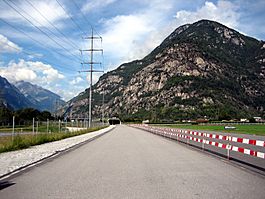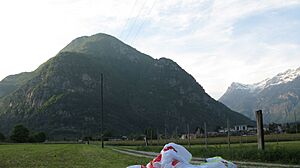Iragna facts for kids
Quick facts for kids
Iragna
|
||
|---|---|---|

The Iragna tunnel of the Gotthard Base
|
||
|
||
| Country | Switzerland | |
| Canton | Ticino | |
| District | Riviera | |
| Area | ||
| • Total | 18.39 km2 (7.10 sq mi) | |
| Elevation | 295 m (968 ft) | |
| Population
(December 2004)
|
||
| • Total | 495 | |
| • Density | 26.92/km2 (69.71/sq mi) | |
| Postal code |
6707
|
|
| Surrounded by | Biasca, Lavertezzo, Lodrino, Osogna, Personico | |
Iragna was once a small town (called a municipality) in Switzerland. It was located in the Ticino area, which is a canton (like a state).
On April 2, 2017, Iragna joined with a few other towns, Cresciano, Lodrino, and Osogna, to form a new, bigger town called Riviera. So, Iragna is now part of Riviera.
Contents
History of Iragna
Iragna was first mentioned in old writings in 1210. Back then, it was called Inagna.
Early Village Life
Iragna was one of ten "Vicini," which were like village groups that worked together. They formed a larger community called Levantine. In 1441, the whole Levantine area, including Iragna, was taken over by Uri.
Later, Iragna became part of an area controlled by the dukes of Milan. During this time, the people of Iragna were allowed to choose their own local leader, called a bailiff. In the 1600s, some people in Iragna were involved in witch trials, which were very serious events at the time.
Old Buildings and Travel Routes
The church of SS Eusebio e Gaudenzio has been used since 1210. This shows how old the community is.
Iragna was on an important road that offered a different way to cross the Alps mountains. Because of this, a special place for travelers (a hospice) was built there in 1288. It helped people on their journeys.
Local Resources
The forests around Iragna were full of chestnut trees. These trees provided wood for people living in the nearby valleys. Also, since the late 1800s, mining for granite has been a big way for people in Iragna to earn money.
Geography and Landscape
Iragna covers an area of about 18.39 square kilometers (about 7.1 square miles). A large part of this land, about 67%, is covered in forests. About 4.4% of the land is used for farming.
Land Use in Iragna
Around 4.1% of Iragna's land has buildings or roads on it. A small part, about 1.6%, is rivers or lakes. The remaining 19.7% is land that isn't used for farming or buildings, like rocky areas.
Most of the built-up areas are homes and other buildings. The forests are mostly dense woods, with some areas of smaller trees and shrubs. All the water in Iragna comes from flowing rivers.
Location on the Ticino River
Iragna is located in the Riviera district. It sits on the right side of the Ticino river.
Coat of Arms
The coat of arms for Iragna is green. It has a special cross shape that looks wavy, and on either side of it are two golden bells.
People of Iragna
Iragna had a population of 495 people as of December 2004. In 2008, about 21.7% of the people living there were from other countries.
Languages Spoken
Most people in Iragna speak Italian language. In 2000, about 91.4% of the population spoke Italian. The second most common language was German, spoken by about 2.4% of the people. A small number of people also spoke Serbo-Croatian, French, and Romansh.
Where People Come From
In 2000, about 40.5% of the people living in Iragna were born there. About 27.3% were born in the same canton (Ticino). Around 6.7% were born in other parts of Switzerland, and about 24.8% were born outside of Switzerland.
Age Groups
Looking at the population in 2009:
- About 9.7% were children aged 0 to 9 years old.
- About 11.6% were teenagers aged 10 to 19.
- Adults aged 20 to 59 made up about 57% of the population.
- Seniors aged 60 and older made up about 21.6% of the population.
Households and Homes
In 2000, there were 190 private households in Iragna, with an average of 2.5 people per home. About 26.3% of homes had only one person living there. There were also many married couples, with and without children.
Most of the buildings in Iragna are single-family homes. In 2000, about 79.1% of the inhabited buildings were single-family homes. Many of these homes were built between 1919 and 1945.
Population Changes Over Time
The chart below shows how the population of Iragna has changed throughout history.

Economy and Jobs
In 2007, Iragna had a low unemployment rate of 3.77%. This means most people who wanted to work had jobs.
Types of Jobs
People in Iragna worked in different types of jobs:
- Primary sector: This includes jobs like farming. In 2005, about 20 people worked in this area.
- Secondary sector: This includes jobs in manufacturing, mining, and construction. In 2005, about 99 people worked in this sector.
- Tertiary sector: This includes jobs in services, like sales, transportation, hotels, and education. In 2005, about 39 people worked in this sector.
In 2008, there were 109 full-time jobs in Iragna. Many jobs were in construction, manufacturing, and hotels or restaurants.
Commuting to Work
In 2000, many people who lived in Iragna traveled to other towns for work (179 people). Fewer people traveled into Iragna for work (80 people). This means more people left Iragna for jobs than came in. Most people (70.7%) used a private car to get to work.
Religion
Based on the 2000 census, most people in Iragna were Roman Catholic (85.1%). A small number of people belonged to the Swiss Reformed Church or other Christian churches. About 4.07% of the population was Islamic. Around 5.91% of people said they had no religion.
Education
In Iragna, about 36% of the population had finished high school (called upper secondary education). About 5.7% had gone on to higher education, like a university.
Schools in Iragna
In 2009, there were 95 students in Iragna.
- Kindergarten: There were 17 children in kindergarten.
- Primary School: This program lasts for five years. There were 27 students in standard primary schools.
- Lower Secondary School: After primary school, students go to middle school for two years or a four-year program to prepare for higher education. There were 25 students in middle school and 6 in the advanced program.
Upper Secondary and Vocational Training
After lower secondary school, students can choose different paths. Some go to vocational schools to learn a trade, like engineering or nursing. There were 4 students attending vocational school full-time and 14 part-time. One student was in a professional program.
In 2000, 24 students from Iragna went to schools outside of the town.
See also
 In Spanish: Iragna para niños
In Spanish: Iragna para niños





